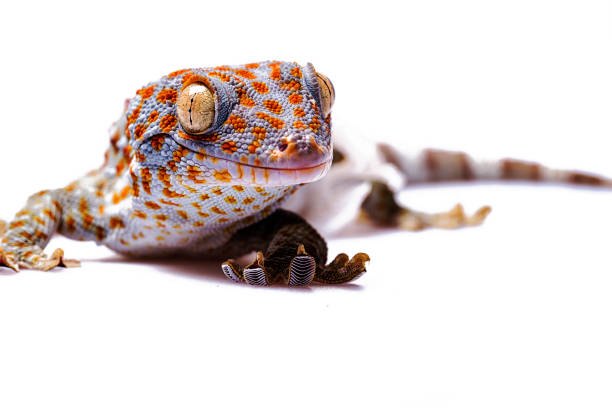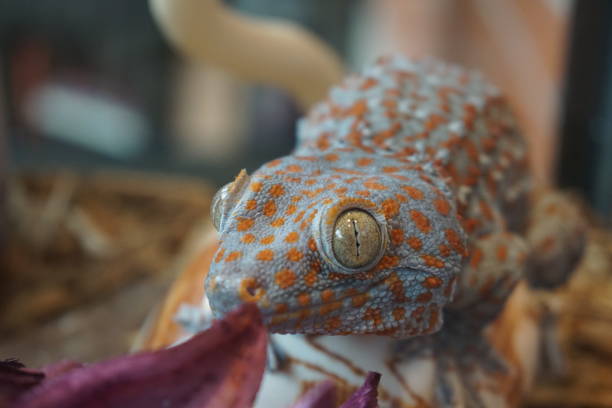
Tokay Geckos, an intriguing species known for their vibrant appearance and distinctive vocalizations, have captivated the curiosity of reptile enthusiasts worldwide. Understanding the breeding habits of these fascinating creatures provides invaluable insights into their reproductive behaviors. This article will examine the unique aspects of Tokay Gecko breeding, shedding light on their courtship rituals, mating behaviors, and reproductive patterns. By delving into the intricacies of their breeding habits, we can gain a deeper appreciation for the remarkable nature of Tokay Geckos.
Breeding Season
The breeding season of Tokay Geckos is influenced by various factors such as temperature, humidity, and the availability of food. These geckos typically reproduce during the warmer months, as the elevated temperatures provide optimal conditions for their reproductive activities. In their natural habitat, breeding season often occurs between April and August, when temperatures range from 25°C to 30°C. However, in captive environments where temperature and lighting can be controlled, Tokay Geckos can be bred throughout the year.
Timing of Breeding Season
During the breeding season, male Tokay Geckos become more active and vocal in their efforts to attract a mate. They emit distinct calls, often described as a loud “tokay,” hence the name of the species. The timing of the breeding season is also influenced by the availability of food sources, as geckos require ample nutrition for successful reproduction.
Duration of Breeding Season
The breeding season for Tokay Geckos usually spans several months, although the exact duration can vary depending on environmental factors. In their natural habitat, the breeding season may last for around three to four months. However, in captive environments, breeding season can be extended artificially by controlling temperature, lighting, and other environmental conditions.
Factors Affecting Breeding Season
Several factors affect the breeding season of Tokay Geckos. Temperature plays a significant role, as it influences the physiology and behavior of these reptiles. Tokay Geckos require a specific temperature range to trigger reproductive activities. Additionally, availability of food and proper nutrition are crucial for successful breeding. High levels of humidity may also play a role in creating optimal conditions for breeding, as it helps maintain the health of the geckos and their eggs.
Mating Behavior
During the breeding season, Tokay Geckos exhibit specific mating behaviors that facilitate successful reproduction. These behaviors include courtship displays, mating rituals, and male competition for mating opportunities.
Courtship Displays
Male Tokay Geckos engage in elaborate courtship displays to attract females. They may vocalize and create chirping sounds to announce their presence and establish dominance. These calls serve as a form of communication to signal their readiness and attractiveness to potential mates.
Mating Rituals
Once the male has attracted a female, a mating ritual ensues. The male approaches the female, often with a series of head movements and tail flicks. The female may signal her receptiveness by wagging her tail or allowing the male to approach closely. If the male is accepted, mating will typically occur, and the female will store sperm for later use during egg fertilization.
Male Competition
During the breeding season, male Tokay Geckos fiercely compete for mating opportunities. Competitors may engage in aggressive behavior, including territorial disputes and physical combat. Dominant males, often determined by size and strength, have a higher likelihood of successfully mating with receptive females.

Nesting
After successful mating, Tokay Geckos proceed to nest construction and egg-laying activities. Nesting behaviors aim to provide a safe and suitable environment for the development of eggs and hatchlings.
Selection of Nesting Site
Female Tokay Geckos select nesting sites that offer protection and optimal conditions for egg incubation. They often choose hidden locations, such as tree hollows or crevices in rocks or buildings. The chosen site should be secure from predators, provide suitable temperature and humidity levels, and offer protection from extreme weather conditions.
Construction of Nest
Female Tokay Geckos construct nests by laying successive layers of moist soil, sand, or other suitable substrates. They may also utilize plant materials or debris to reinforce the nest structure. The careful construction of the nest helps maintain a stable environment for the developing eggs.
Females Guarding Eggs
After laying their eggs, female Tokay Geckos often assume the role of protecting the nest. They may remain in close proximity, guarding against potential threats. This behavior ensures the safety and survival of the developing eggs until they hatch.
Egg Clutch
Tokay Geckos produce egg clutches as part of their reproductive process. These clutches consist of multiple eggs and play a vital role in the continuation of the species.
Egg Production
Female Tokay Geckos typically produce multiple clutches of eggs throughout the breeding season. Each clutch can contain a varying number of eggs, typically ranging from two to four. The total number of egg clutches produced by an individual female during one breeding season can greatly influence the population’s growth and survival.
Incubation Duration
The incubation duration of Tokay Gecko eggs depends on several factors, including temperature and humidity. It typically takes around 60 to 90 days for the eggs to hatch. Higher temperatures can accelerate the incubation process, while lower temperatures can delay it. Proper monitoring and control of temperature and humidity are crucial to ensure successful incubation.
Predation Threats
During the incubation period, Tokay Gecko eggs face numerous predation threats. Various animals, including snakes, birds, and mammals, may target the eggs as a source of food. The female’s vigilant guarding behavior helps minimize these threats and increases the chances of successful hatchling emergence.
Hatchlings
Once the incubation period is complete, Tokay Gecko hatchlings emerge from their eggs. This marks the beginning of a new generation of geckos and introduces a whole new set of challenges and milestones.
Emergence from Eggs
Hatchlings use a specialized tooth-like structure called an egg tooth to break through the shell and emerge into the outside world. This process can take several hours or even days, and the hatchlings must exert considerable effort to free themselves completely.
Yolk Sac Absorption
After hatching, Tokay Gecko hatchlings still possess a yolk sac attached to their belly. This yolk sac acts as a source of nourishment for the hatchlings during their initial days of life. As the hatchlings grow, they gradually absorb the nutrients from the yolk sac until it is fully depleted.
Maternal Care
Unlike many reptiles, Tokay Geckos exhibit some form of maternal care towards their hatchlings. The female may remain near the hatchlings, ensuring their safety and providing protection from potential threats. This care helps the hatchlings navigate the initial stages of life and increases their chances of survival.
Sex Determination
The sex of Tokay Geckos is determined by various factors, including temperature-dependent sex determination (TSD) and genetic sex determination (GSD).
Temperature-dependent Sex Determination
Temperature-dependent sex determination occurs in Tokay Geckos, where the incubation temperature of the eggs influences the resulting sex of the hatchlings. Lower temperatures tend to produce female hatchlings, while higher temperatures result in male hatchlings. Critical temperature thresholds during a specific period in the incubation process dictate the sex determination.
Genetic Sex Determination
Some Tokay Geckos exhibit genetic sex determination, where specific genes inherited from the parents determine the sex of the offspring. This mechanism operates independently of temperature and relies on the presence or absence of certain genes or combinations of genes.
Factors Influencing Sex Ratio
Several factors can influence the sex ratio in Tokay Geckos. Temperature is a crucial factor, as slight variations in incubation temperature can significantly impact the sex ratio of the hatchlings. Additionally, genetic factors within the breeding population can also influence the proportion of males to females in subsequent generations.

Breeding Frequency
Tokay Geckos exhibit varying breeding frequencies, influenced by factors such as environmental conditions, available resources, and reproductive success.
Multiple Clutches in a Season
Female Tokay Geckos are capable of producing multiple clutches of eggs during a single breeding season. Successful reproduction and optimal environmental conditions can contribute to increased breeding frequency. However, it is important to ensure that the female has enough time to recover and regain her energy reserves between clutches.
Interval between Clutches
The duration between successive clutches can vary among Tokay Geckos. It typically takes several weeks for the female to produce and lay a new clutch of eggs after successfully breeding and laying a previous clutch. This interval allows the female to replenish her nutrient reserves and prepare for the next reproductive cycle.
Mating Behavior After Clutch
Once the female has laid a clutch of eggs, the mating behavior may change. Male Tokay Geckos may continue to attempt to mate with the female to ensure successful fertilization of subsequent clutches. However, the female may become less receptive to mating advances as she focuses on nesting and incubating the recently laid eggs.
Parental Care
Tokay Geckos exhibit various forms of parental care, which help promote the survival and development of their offspring.
Male Parental Care
In some instances, male Tokay Geckos display parental care behavior. They may assist in guarding the nest and protecting the eggs from potential threats. This behavior increases the chances of successful incubation and emergence of hatchlings.
Female Parental Care
Female Tokay Geckos primarily exhibit parental care behaviors, including nest construction, egg-laying, and vigilant guarding of the nest and hatchlings. The female’s presence and care contribute significantly to the survival and well-being of the offspring.
Predation Risks for Parents
While caring for their offspring, both male and female Tokay Geckos face predation risks. Predators may target the nesting site or attempt to prey upon the eggs or hatchlings. The parents must balance their parental care responsibilities with the need to protect themselves from potential threats.
Juvenile Growth
Once hatchlings emerge, they undergo a crucial growth period, transitioning from vulnerable hatchlings to juveniles capable of surviving on their own.
Growth Rate
The growth rate of Tokay Gecko juveniles can vary, influenced by factors such as nutrition, environmental conditions, and genetic factors. A proper diet and suitable habitat conditions promote healthy growth, ensuring the development of strong and robust individuals.
Developmental Stages
Juvenile Tokay Geckos go through various developmental stages, gradually acquiring adult characteristics. They undergo physical changes such as growth in size, coloration, and the development of their distinctive vocalizations.
Cannibalism among Juveniles
In some cases, Tokay Gecko juveniles may exhibit cannibalistic tendencies. This behavior can occur when resources are limited, and competition for food and territory intensifies. Cannibalism among juveniles helps regulate population numbers and ensures the survival of stronger individuals.
Breeding in Captivity
Breeding Tokay Geckos in captive environments has become increasingly popular among reptile enthusiasts and breeders due to their stunning appearance and unique behaviors.
Reproducing in Captive Environments
Breeding Tokay Geckos in captivity provides several advantages, including controlled environmental conditions, absence of natural predators, and enhanced reproductive success rates. Breeders can manipulate temperature, lighting, and humidity to ensure optimal breeding conditions throughout the year.
Environmental Factors
Creating a suitable environment for breeding Tokay Geckos in captivity involves replicating their natural habitat as closely as possible. This includes providing appropriate substrates, hiding spots, and climbing structures. Maintaining proper temperature, humidity, and lighting conditions is crucial for successful breeding and the overall well-being of the geckos.
Artificial Incubation Techniques
In captive breeding programs, artificial incubation techniques are commonly employed to ensure successful hatching of Tokay Gecko eggs. Careful monitoring of temperature, humidity, and egg orientation helps mimic the conditions for natural incubation. Such techniques allow breeders to control and optimize the incubation process, increasing the chances of successful hatchling emergence.
In conclusion, understanding the breeding habits of Tokay Geckos provides valuable insights into their reproductive biology and informs efforts to conserve and manage their populations. Factors such as the breeding season, mating behaviors, nesting activities, and parental care all contribute to the survival and success of these fascinating reptiles. By studying and appreciating their breeding habits, we can contribute to the preservation of these unique creatures and ensure their continued presence in our world.
